Introduction to Direct and Indirect Objects:
Direct and indirect objects are crucial components of English sentences, providing clarity and depth to the action being performed. In this lesson, we'll delve deeper into understanding direct and indirect objects, explore their differences, provide comprehensive examples, discuss their roles in sentence structure, highlight common mistakes, and touch upon the use of pronouns to represent direct and indirect objects.

1. Direct vs Indirect Objects: Clarifying the Distinction: Direct objects directly receive the action of the verb, while indirect objects indicate to or for whom or what the action of the verb is performed. The distinction can be summarised as follows:
- Direct objects receive the action directly.
- Indirect objects receive the direct object.
2. Examples of Direct and Indirect Objects: Let's explore examples to understand these concepts better:
- "She bought a new car." (No direct or indirect object)
- "He read the book." (Direct object: "the book")
- "She gave him a present." (Direct object: "a present"; Indirect object: "him")
- "I wrote my friend a letter." (Direct object: "a letter"; Indirect object: "my friend")
- "They offered her the job." (Direct object: "the job"; Indirect object: "her")
3. Identifying Direct and Indirect Objects:
Direct objects typically follow transitive verbs immediately, while indirect objects come after the direct object, usually preceded by the prepositions "to" or "for." Practice and understanding verb transitivity aids in identifying these objects accurately.
4. Role in Sentence Structure:
Direct and indirect objects contribute significantly to sentence structure, offering additional information and clarifying relationships within sentences. They help convey the action and its recipients clearly.
5. Common Mistakes and Object Pronouns:
Common mistakes include using incorrect pronouns for direct and indirect objects and confusing them with objects of prepositions. Object pronouns, such as "me," "him," "her," etc., can replace direct and indirect objects in sentences while maintaining clarity and grammatical correctness.
Conclusion: Understanding direct and indirect objects is fundamental for constructing clear and coherent sentences in English. By mastering these concepts and practising their application, learners can enhance their communication skills and express ideas effectively.

Feedback
Total score is 2 out of 7 (25%)
C1-C2 Grammar : Direct and Indirect Objects
Choose the correct word.